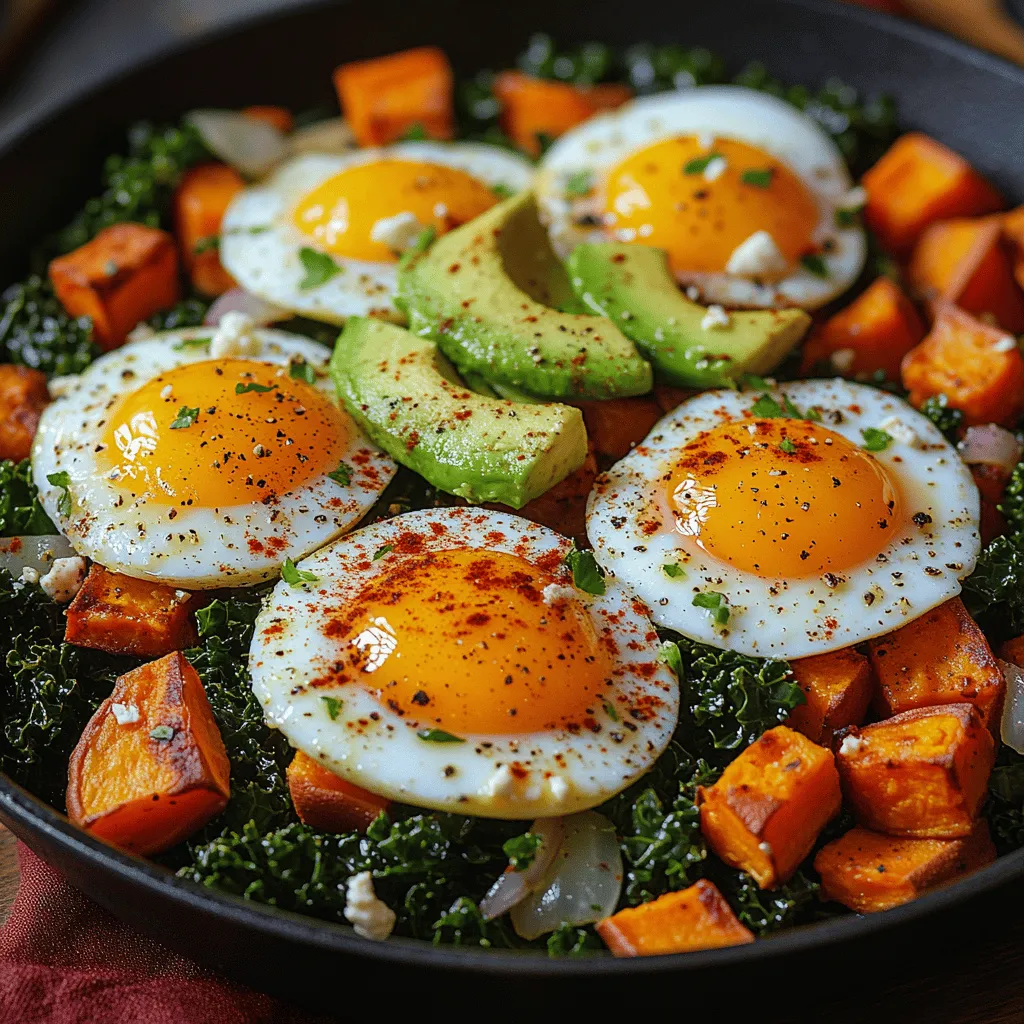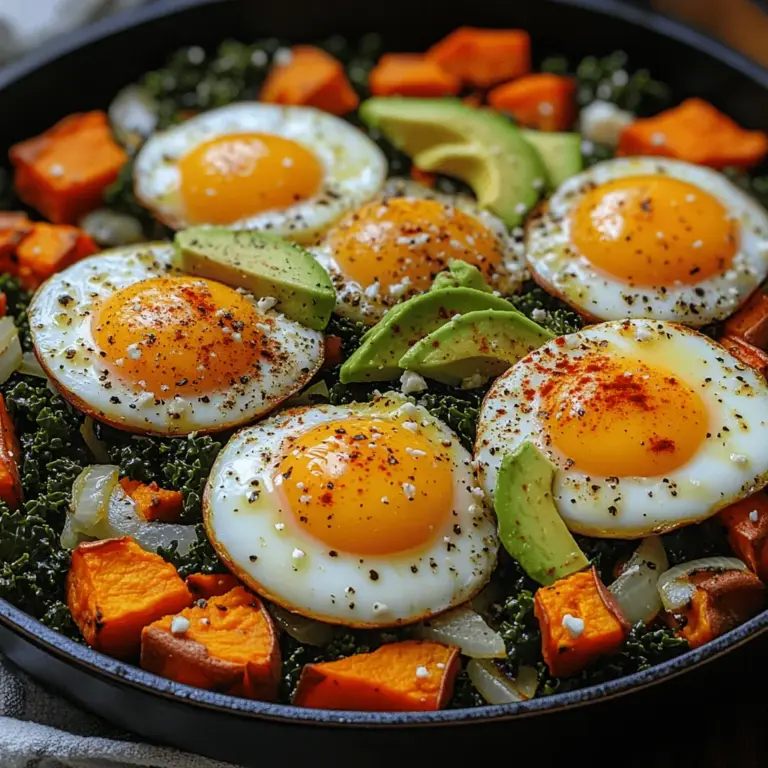In the world of breakfast, finding a dish that is both nutritious and flavorful can often feel like a challenge. Enter the Sweet Potato Kale Breakfast Skillet—an incredibly satisfying dish that combines vibrant ingredients into a wholesome breakfast that fuels your day. This recipe is not only a delightful combination of colors and textures but also a powerhouse of nutrients that will keep you energized throughout your morning.
Sweet potatoes are the star of this skillet, bringing a natural sweetness and creaminess that complements the earthy kale and the aromatic flavors of onions and garlic. Packed with vitamins, minerals, and healthy fats, this dish not only pleases the palate but also supports your overall well-being. It’s a perfect option for anyone looking to incorporate more vegetables into their morning routine, whether you’re a devoted vegetarian or simply someone who appreciates a hearty, nutritious breakfast.
In this article, we’ll explore the ingredients, preparation methods, and the nutritional benefits of this delightful breakfast option. Let’s dive into the details that make this Sweet Potato Kale Breakfast Skillet a must-try recipe.
Understanding the Ingredients
Exploring Sweet Potatoes
Sweet potatoes are a versatile and nutritious root vegetable that serves as the foundation of this breakfast skillet. They are not only delicious but also incredibly good for you, making them a great choice for breakfast or any meal of the day.
Nutritional Profile of Sweet Potatoes
Sweet potatoes are rich in essential vitamins and minerals. A medium-sized sweet potato typically contains:
– Vitamin A: Sweet potatoes are one of the best sources of beta-carotene, which the body converts into vitamin A. This vitamin is crucial for maintaining healthy vision, skin, and immune function.
– Vitamin C: This antioxidant helps protect your cells from damage, supports your immune system, and aids in collagen production for healthy skin.
– Fiber: Sweet potatoes are high in dietary fiber, which promotes digestive health and can help you feel full longer.
– Potassium: This mineral is important for heart health and helps regulate blood pressure.
Health Benefits
Incorporating sweet potatoes into your diet can provide numerous health benefits. Their high fiber content aids digestion and can help prevent constipation. The antioxidants found in sweet potatoes are known to reduce inflammation and may enhance overall health. Additionally, their low glycemic index makes them a smart choice for those looking to manage their blood sugar levels.
Tips for Selecting and Storing Sweet Potatoes
When selecting sweet potatoes, look for ones that are firm, smooth, and free of blemishes or soft spots. The color can vary from orange to purple, and each type has its unique taste and texture. Store sweet potatoes in a cool, dark place with good ventilation. Avoid refrigerating them, as cold temperatures can alter their flavor and texture. Proper storage can keep them fresh for several weeks.
Delving into Kale
Kale has gained popularity in recent years as a superfood, and for good reason. Its nutrient density makes it an excellent addition to any meal, especially breakfast.
Nutritional Benefits of Kale
Kale is loaded with vitamins, antioxidants, and minerals. A cup of raw kale contains:
– Vitamin K: Essential for blood clotting and bone health, kale is one of the best sources of vitamin K.
– Vitamin C: Like sweet potatoes, kale is also rich in vitamin C, contributing to immune support and skin health.
– Antioxidants: Kale is packed with antioxidants, which help combat oxidative stress in the body and reduce the risk of chronic diseases.
Different Varieties of Kale and Their Characteristics
There are several varieties of kale, including curly kale, Lacinato (or dinosaur) kale, and red Russian kale. Curly kale is commonly found in grocery stores and has a robust texture. Lacinato kale has a flatter, darker leaf and a slightly sweeter taste, making it a favorite for salads and cooking. Red Russian kale is milder and has a beautiful purple hue, adding visual appeal to dishes.
How to Properly Wash and Prepare Kale
Before using kale, it’s essential to wash it thoroughly to remove any dirt or pesticides. To prepare kale, remove the thick stems by holding the leaf in one hand and pulling the stem away with the other. The leaves can be chopped or left whole, depending on your preference. For this recipe, we recommend tearing the kale into bite-sized pieces to ensure even cooking.
The Role of Aromatics
Aromatics play a crucial role in building flavor in any dish, and this breakfast skillet is no exception. Onions, garlic, and bell peppers contribute depth and complexity to the overall flavor profile.
Importance of Onions and Garlic in Flavor Building
Onions and garlic are staples in many cuisines around the world due to their aromatic qualities. When sautéed, onions become sweet and tender, while garlic adds a pungent, savory note that enhances the dish. Together, they form a flavorful base that complements the sweetness of the sweet potatoes and the earthiness of the kale.
Benefits of Including Bell Peppers in Your Breakfast
Bell peppers add a pop of color, crunch, and a subtle sweetness to the skillet. They are also a great source of vitamins A and C, making them a nutritious addition to your breakfast. The vibrant colors of bell peppers can also make your dish visually appealing, inviting you to enjoy the meal even more.
Overview of Spices Used: Smoked Paprika and Cumin
Spices elevate the flavor of any dish, and in this breakfast skillet, smoked paprika and cumin are key players. Smoked paprika adds a rich, smoky flavor that pairs beautifully with the sweet potatoes, while cumin introduces warm, earthy notes that enhance the overall taste. Together, these spices create a comforting and satisfying flavor profile that will make you look forward to breakfast.
Preparation Method
With a clear understanding of the ingredients, it’s time to dive into the preparation method for the Sweet Potato Kale Breakfast Skillet. The following steps will guide you through the process of creating this delicious and nutritious meal.
Preparing the Sweet Potatoes
Sweet potatoes are the heart of this dish, and proper preparation is essential for achieving the best texture and flavor.
Step-by-Step Guide to Peeling and Dicing Sweet Potatoes
1. Peeling: Start by washing the sweet potatoes under running water to remove any dirt. Using a vegetable peeler or a sharp knife, carefully peel the skin off, ensuring you remove any blemishes.
2. Dicing: Once peeled, place the sweet potato on a cutting board and slice it lengthwise into 1-inch thick planks. Stack the planks and cut them into 1-inch wide strips. Finally, dice the strips into small cubes that are roughly uniform in size to ensure even cooking.
Cooking Techniques: Sautéing vs. Baking
While you can bake sweet potatoes for a softer texture, sautéing is the preferred method for this recipe. Sautéing allows for quicker cooking and helps achieve a beautiful caramelization on the edges, enhancing the flavor.
To sauté sweet potatoes, heat a tablespoon of olive oil in a large skillet over medium heat. Once the oil is shimmering, add the diced sweet potatoes and season with salt and pepper. Cook for about 10-15 minutes, stirring occasionally, until the sweet potatoes are tender and golden brown.
Tips for Achieving the Perfect Caramelization
To achieve perfect caramelization, avoid overcrowding the skillet, as this can cause the sweet potatoes to steam rather than brown. Ensure that the sweet potatoes are in a single layer in the skillet, allowing them to crisp up nicely. If necessary, cook them in batches to maintain the right cooking temperature.
Adding Aromatics for Flavor
Once the sweet potatoes are cooked to perfection, it’s time to add the aromatics that will elevate the dish.
The Importance of Sautéing Onions and Bell Peppers
After removing the sweet potatoes from the skillet, add a bit more olive oil if needed. Begin by adding diced onions to the hot skillet. Sauté the onions for about 3-4 minutes until they become translucent. Next, add the bell peppers and continue cooking for another 3-5 minutes until they soften and begin to caramelize.
How to Properly Mince Garlic for Optimal Flavor
Garlic should be added towards the end of the cooking process to prevent it from burning. To mince garlic, start by smashing a clove with the flat side of a knife to loosen the skin. Remove the skin and chop the garlic finely, or use a garlic press for a smoother consistency. Add the minced garlic to the skillet with the onions and bell peppers, cooking for about 30 seconds until fragrant. This step ensures the garlic infuses the dish with its aromatic flavor without becoming bitter.
As you continue with the preparation of the Sweet Potato Kale Breakfast Skillet, you’ll be well on your way to creating a flavorful and nutritious meal that sets a positive tone for your day. Stay tuned for the next steps in assembling this delightful dish!

Balancing Spices: How Smoked Paprika and Cumin Enhance the Dish
When preparing the Sweet Potato Kale Breakfast Skillet, the choice of spices plays a crucial role in elevating the overall flavor profile. Smoked paprika and cumin are two standout spices that not only bring warmth and depth to the dish but also complement the natural sweetness of the sweet potatoes.
Smoked Paprika: This spice introduces a subtle smokiness that enhances the earthiness of the sweet potatoes. The rich, deep flavor of smoked paprika adds complexity, making each bite more satisfying. It also brings a beautiful reddish hue to the dish, visually appealing for breakfast.
Cumin: Known for its warm, nutty flavor, cumin works harmoniously with the other ingredients. It adds a distinctive aroma that can awaken your senses, making your breakfast feel more exotic. Together, smoked paprika and cumin create a balanced seasoning that enhances the wholesome ingredients without overpowering them.
Incorporating Kale into the Skillet
Kale is the star green in this breakfast skillet, and knowing how to incorporate it effectively can make all the difference. This leafy green is not only nutrient-rich but also boasts a hearty texture that stands up well to cooking.
Techniques for Wilting Kale Without Losing Nutrients
To ensure that you preserve the nutrients while wilting kale, follow these steps:
1. Quick Sauté: Add the kale to the skillet once the sweet potatoes are nearly tender. This allows it to cook quickly without losing vital nutrients.
2. Steam Method: If you prefer, you can cover the skillet for a minute after adding the kale. This short steam will wilt the greens while retaining their vibrant color and nutritional value.
3. Avoid Overcooking: Keeping the cooking time short is key. Kale can become mushy if cooked for too long, so aim for 2-3 minutes until the leaves are vibrant and tender but still have a bit of bite.
Importance of Seasoning During the Cooking Process
Seasoning is essential not just at the end but throughout the cooking process. As you add the kale to the skillet, sprinkle a pinch of salt and a dash of pepper. This will enhance the natural flavors of the kale and ensure it absorbs the seasoning. Layering flavors helps create a more complex and satisfying dish, enhancing both taste and nutrition.
How to Achieve the Perfect Texture with Cooked Kale
The goal is to have kale that is tender yet retains some texture. Here are tips to achieve this:
– Chop the Kale: Before adding it to the skillet, chop the kale into bite-sized pieces. This allows for even cooking and makes it easier to incorporate into the dish.
– Toss Frequently: Stir the kale within the skillet as it wilts. This ensures that all pieces receive equal heat and seasoning, resulting in an even texture.
– Taste as You Go: Always taste the kale as it cooks. If it’s still too tough for your liking, give it a little more time, but keep a close eye to avoid overcooking.
Cooking the Eggs
Eggs are a classic breakfast staple, and cooking them in the skillet can add a delightful richness to your Sweet Potato Kale Breakfast Skillet.
Different Methods for Cooking Eggs in a Skillet
There are several ways to cook the eggs in this dish:
– Sunny-Side Up: For a vibrant, runny yolk, crack the eggs directly into the wells created in the skillet. Cover the skillet to help the tops of the eggs cook while keeping the yolks runny.
– Over-Easy: If you prefer a slightly firmer yolk, flip the eggs after a few minutes of cooking sunny-side up. This method cooks the yolk while still allowing for some creaminess.
– Scrambled: For a different texture, whisk the eggs in a bowl before pouring them into the skillet. Stir continuously until they reach your desired level of doneness.
Understanding Egg Doneness: Runny vs. Fully Cooked
Egg doneness can be a matter of personal preference. Here’s a simple guide:
– Runny Yolks: Cook for about 3-4 minutes on medium heat. The whites should be set, while the yolk remains soft and runny.
– Fully Cooked Yolks: If you prefer fully cooked yolks, allow the eggs to cook for an additional minute or two. The whites should be firm and the yolks should not jiggle.
Tips for Creating Perfect Wells for Eggs in the Skillet
Creating wells for the eggs is essential for an integrated meal. Here’s how to do it:
1. Use the Back of a Spoon: After adding the sweet potatoes and kale, use the back of a spoon to make small indentations in the mixture.
2. Space Them Evenly: Ensure the wells are spaced evenly to allow for multiple eggs to be cooked simultaneously.
3. Add Oil or Butter: Before cracking the eggs into the wells, add a small amount of oil or butter to prevent sticking.
Serving Suggestions
Presentation can transform a simple breakfast into a delightful feast. Here are some ideas to elevate your Sweet Potato Kale Breakfast Skillet.
Creative Plating Techniques for a Beautiful Breakfast
– Layering: Serve the skillet mixture in a shallow dish, layering the sweet potatoes, kale, and eggs for a beautiful presentation.
– Garnishing: Top with freshly chopped herbs such as parsley or cilantro to add a pop of color and freshness. A sprinkle of smoked paprika can also enhance the visual appeal.
Exploring Optional Toppings: Avocado, Hot Sauce, Feta, and Herbs
Boost the flavor and texture of your meal with these optional toppings:
– Avocado: Sliced or smashed avocado adds creaminess and healthy fats to the dish.
– Hot Sauce: A drizzle of your favorite hot sauce can provide a spicy kick that complements the sweetness of the potatoes.
– Feta Cheese: Crumbled feta offers a tangy contrast that pairs beautifully with the sweetness of the sweet potatoes and the earthiness of the kale.
– Fresh Herbs: Consider adding fresh dill or chives for an aromatic touch.
Pairing Suggestions: What to Serve Alongside Your Skillet Meal
To complete your breakfast experience, consider these pairing options:
– Whole Grain Toast: A slice of whole grain bread or an English muffin complements the dish and adds extra fiber.
– Fresh Fruit: A side of mixed berries or sliced oranges can brighten the plate and provide a refreshing contrast to the savory skillet.
– Coffee or Herbal Tea: A warm beverage can enhance the comforting nature of this meal, making it a perfect start to your day.
Nutritional Benefits
The Sweet Potato Kale Breakfast Skillet is not only delicious but also packed with nutritional benefits.
Balancing Macronutrients
This dish offers a well-rounded macronutrient profile:
– Carbohydrates: Sweet potatoes provide complex carbohydrates, which are essential for sustained energy throughout the day.
– Protein: Eggs are an excellent source of high-quality protein, essential for muscle repair and overall health.
– Healthy Fats: If you choose to add avocado or cook with olive oil, you introduce healthy fats that are important for heart health and satiety.
Vitamins and Minerals
Each ingredient in the Sweet Potato Kale Breakfast Skillet contributes to a range of vitamins and minerals:
– Sweet Potatoes: Rich in vitamin A, which is crucial for eye health and immune function.
– Kale: Packed with vitamins K, C, and A, along with minerals like calcium and magnesium.
– Eggs: Contain B vitamins, vitamin D, and essential amino acids, supporting various bodily functions.
This breakfast is not just filling; it contributes significantly to a balanced diet, providing vital nutrients that support overall well-being.
Conclusion
The Sweet Potato Kale Breakfast Skillet is not just another breakfast option; it is a vibrant, nutrient-packed meal that brings joy to the morning routine. With its combination of sweet potatoes, kale, and perfectly cooked eggs, this dish is a testament to how wholesome ingredients can come together to create something truly delightful. Whether you’re cooking for yourself or sharing with loved ones, this recipe offers a satisfying start to the day that nourishes the body and lifts the spirit. Embrace the flavors and health benefits of this breakfast skillet, and enjoy the delicious journey it brings to your table.

